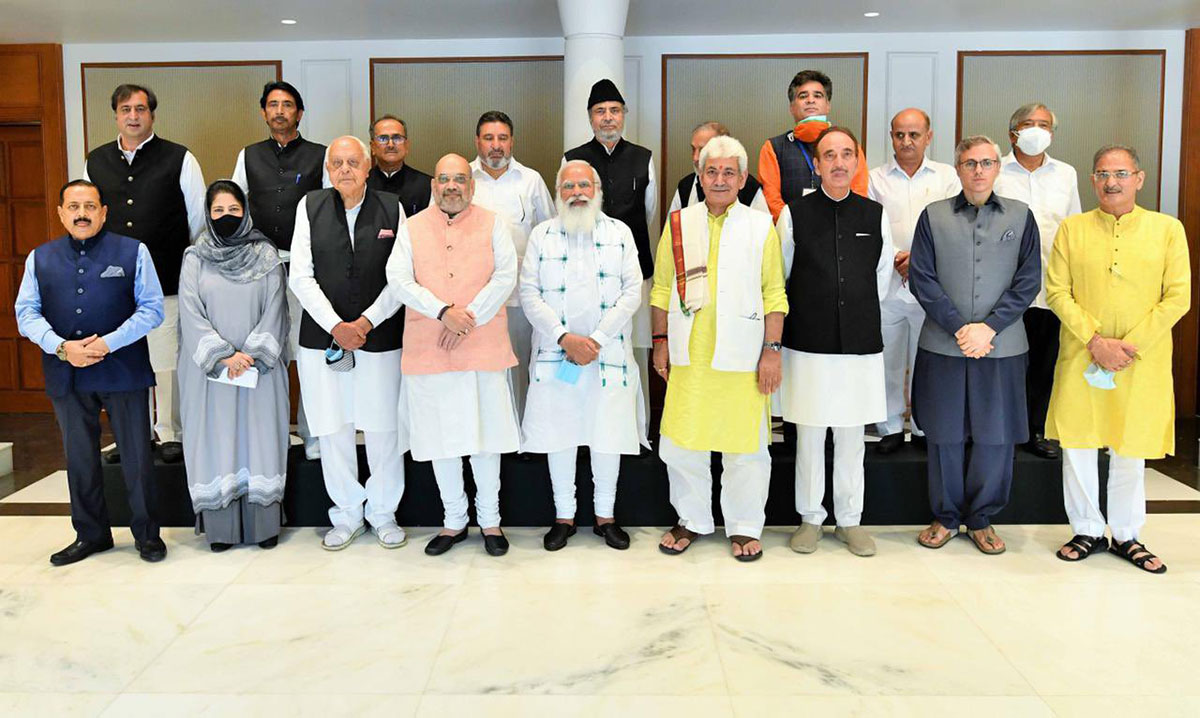If we go by the outcome of the PM’s all-party meeting with Jammu and Kashmir politicians, the centre has stayed true to its course on Kashmir, writes Riyaz Wani

Everyone in Jammu and Kashmir looked forward to the meeting of the leaders of the political parties with Prime Minister Narendra Modi on June 24. But for a large majority of people, there’s little reason for celebration at the outcome of the much-hyped event. The Prime Minister has offered no timeframe on the restoration of the statehood, the maximum the centre is willing to give.
In a tweet, Modi laid stress on the completion of the delimitation exercise to be followed by the elections. The home minister Amit Shah said as much in his tweet. The statehood has been promised to follow after the elections. Whether full or truncated, it is unclear yet.
The Change
So what has changed before and after June 24? Nothing except some good optics: a smiling picture of prominent Jammu and Kashmir politicians with the Prime Minister and Home Minister. This could be called something since almost all the Kashmiri leaders who participated in the meeting had been detained following the withdrawal of Article 370 on August 5, 2019. So, the meeting had a certain value in itself: it signalled a sort of outreach, re-engagement and reconciliation. This should come in handy to Delhi, which is believed to have been under some international pressure to engage with Kashmiri parties.
The meeting, in a sense, made it out of question to talk about the restoration of Article 370 that granted Jammu and Kashmir semi-autonomous under India’s constitution. Though the PDP leader Mehbooba Mufti made a pitch for a reversal of the August 5 move, and to a lesser degree, the NC president Dr Farooq Abdullah made the same demand, the general accent was on the return of full statehood. But the leaders received no assurance that it will be restored anytime soon.
Delimitation
As for the delimitation exercise and the elections, these fall very much in the existing Kashmir agenda of the centre. The delimitation of the electoral constituencies is sought to give more assembly seats to the Jammu division. And to this end, a delimitation commission has been working for the last one and a half year.
The exercise is due to change the electoral game in Kashmir. The commission set up by the government is likely to enhance the seats for Jammu making it politically at par with Kashmir.

Were that to happen, a Jammu based party like the BJP would have more political weight in the future Assembly. And even if a Kashmir based party were to form or lead in a future government, it would have little manoeuvring space to carry out its agenda or overturn the laws passed by the Delhi backed administration over the last two years.
Similarly, elections in a Union Territory would change little. An elected government would be subservient to the Lt Governor and can’t do much except deliver basic governance. Besides, if this government is equally split between Kashmir and Jammu, it will be only further hobbled. Kashmir will feel more marginalized.
So, unless a full statehood is restored nothing much will change on the ground. But this is unlikely to happen. A Kashmir dominated government in a full-fledged state could threaten to undo some of the administrative measures and even laws passed over the last two years. Considering the systematic way in which the centre has gone about executing its Kashmir agenda so far, it will loathe seeing parts of it unravel.
Prime Minister and the Home Minister have promised nothing that would signal any shift in the centre’s Kashmir policy.
Why APM?
But if the centre is not ready to change anything, why did it call a meeting at the highest level? The political analysts in India trace the need to do so to the geopolitical imperatives. Over the last two years, the situation in India’s neighbourhood has transformed in many ways.
The US is exiting Afghanistan paving the way for the takeover of the Taliban sooner or later. This could deepen India’s security challenges. China is in Ladakh over the last year. The communist giant has staged incursions at five points along the Line of Control. Last year, 20 Indian soldiers were killed in a skirmish with the People’s Liberation Army, which also lost four of its soldiers. The new conflict with China and a long-running antagonism with Pakistan has created “a two-front situation” for India.
Delhi has sought to address this difficult state of affairs by engaging Pakistan. According to media reports, not denied by the top officials of either country, a back-channel dialogue is going on between them. In February, the neighbours re-affirmed the 2003 ceasefire agreement along the LoC.
Pakistan seeks reversal of Article 370 move for the bilateral dialogue to begin a dialogue. Short of that Pakistan has shown itself inclined to accept full statehood for Jammu and Kashmir along with protection for the former state’s demographic composition.
But as things stand, there’s a yawning gulf between what Delhi seems ready to do and what Islamabad seeks. And if Delhi gives no concession to Pakistan, the relations between them could go back to square one sooner than later. It remains to be seen how Delhi responds to the evolving situation in the weeks and months ahead. And until then people in Kashmir will have no option but to keep their fingers crossed.















